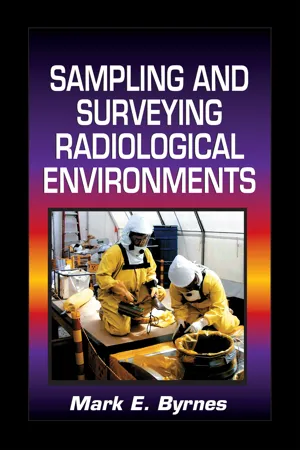
- 440 pages
- English
- ePUB (mobile friendly)
- Available on iOS & Android
Sampling and Surveying Radiological Environments
About this book
Private landowners or Federal Agencies responsible for cleaning up radiological environments are faced with the challenge of clearly defining the nature and extent of radiological contamination, implementing remedial alternatives, then statistically verifying that cleanup objectives have been met. Sampling and Surveying Radiological Environments provides the how-tos for designing and implementing cost effective and defensible sampling programs in radiological environments, such as those found in the vicinity of uranium mine sites, nuclear weapons production facilities, nuclear reactors, radioactive waste storage and disposal facilities, and nuclear accidents. It includes downloadable resources that walk you through the EPA's Data Quality Objectives(DQO) procedures and provides electronic templates you can complete and print.
Sampling and Surveying Radiological Environments addresses all of the major topics that will assist you in designing and implementing statistically defensible sampling programs in radiological environments, including:
· Internet addresses where you can find regulations pertaining to each States
Frequently asked questions
- Essential is ideal for learners and professionals who enjoy exploring a wide range of subjects. Access the Essential Library with 800,000+ trusted titles and best-sellers across business, personal growth, and the humanities. Includes unlimited reading time and Standard Read Aloud voice.
- Complete: Perfect for advanced learners and researchers needing full, unrestricted access. Unlock 1.4M+ books across hundreds of subjects, including academic and specialized titles. The Complete Plan also includes advanced features like Premium Read Aloud and Research Assistant.
Please note we cannot support devices running on iOS 13 and Android 7 or earlier. Learn more about using the app.
Information
CHAPTER 1
Introduction
- A template to support the implementation of the scoping process
- Guidance on regulatory interfacing
- Details on how to implement the EPA seven-step DQO process
- Guidance on developing statistical sampling and survey designs
- Guidance on developing integrated sampling and surveying designs
- Information on capabilities of various statistical sampling design software packages
- Guidance on developing a Sampling and Analysis Plan
- Information on capabilities of various scanning and direct measurement methods
- Standard operating procedures for media sampling
1.1 RADIOLOGICAL CONTAMINANT SOURCES
- Landfills
- Trenches
- Waste water and cooling water holding ponds
- Cribs
- French drains
- Aboveground or underground storage tanks
- Waste container storage yards

1.2 IMPACTED MEDIA
- Soil
- Sediment
- Sludge
- Surface water
- Groundwater
- Air
- Piping
- Ventilation ducts
- Concrete
- Asphalt
- Sheetrock
- Wood
- Roofing material
- Paint
1.3 CONTAMINANT MIGRATION PATHWAYS AND ROUTES OF EXPOSURE
- Air
- Surface water
- Groundwater
Table of contents
- Cover
- Half Title
- Title Page
- Copyright Page
- Preface
- Author
- Contributors
- Table of Contents
- Abbreviations
- Acknowledgments
- Dedication
- Chapter 1 Introduction
- Chapter 2 Environmental Laws and Regulations
- Chapter 3 Radiation and Radioactivity
- Chapter 4 Sampling and Surveying Radiological Environments
- Chapter 5 Sample Preparation, Documentation, and Shipment
- Chapter 6 Data Verification and Validation
- Chapter 7 Radiological Data Management
- Chapter 8 Data Quality Assessment
- Chapter 9 Equipment Decontamination
- Appendix A Data Quality Objectives Summary Report Template
- Appendix B Sampling and Analysis Plan Template
- Appendix C Statistical Tables
- Appendix D Metric Conversion Chart
- Appendix E Radiological Decay Chains
- Appendix F Sample Containers, Preservation, and Holding Times
- Index